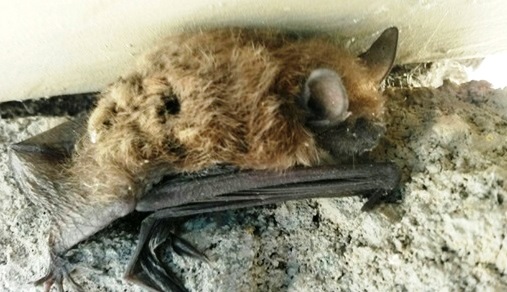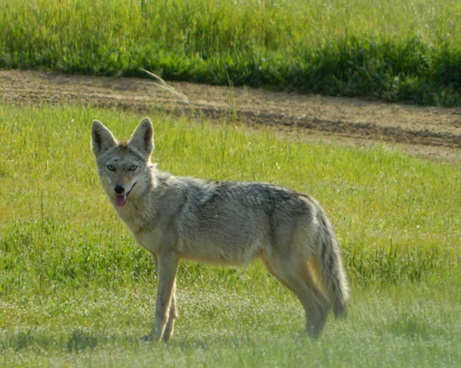Mammals
Bat

Image: Lucas Dickey, LPSRA Staff
California has a number of bat species that can be seen darting through the air at twilight when birds have already gone to roost. You may spot them from the corner of your eye as they zip about catching insects out of the air. They especially enjoy flies ad moths. Bats use echolocation, much like dolphins, to locate prey in the air; they make a series of ultra-sonic clicks and are able to "see" images and locations based on the echo that returns to the bat.
This little brown bat may be a California Myotis. They generally form small colonies of less than 10 individuals and roost on buildings, in rock crevices, and tree hollows. You may see these tiny fellows all alone, like this one, tucked up in a shady corner of a building to sleep during the day. Usually they are just fine and not in need of rescuing-- once the sun goes down, the bat will make its way back outside to hunt again and it will reunite with the rest of its colony. The females of this species typically have one baby each year in late May and early June.
Bobcat

Image: Coyote at Pacheco State Park, Lee Sencenbaugh, Four Rivers Sector
Lake Perris is home to at least one of these solitary, elusive felines. Bobcats are nocturnal and shy, so humans rarely spot them in the wild. They are twice the size of the average housecat; up to three and a half feet long and weighing up to 30 pounds. They have very large feet, tufted ears, and a distinctly short, black-tipped tail that gives this wildcat its name. Though they typically eat rabbits, birds, mice, and squirrels, they have been known to take down animals much larger than they.
Resources:
Bobcat, (2016). National Geographic. http://animals.nationalgeographic.com/animals/mammals/bobcat/
California Ground Squirrel
Under normal circumstances, these little fellows will eat insects, flowers, and smaller mammals and lizards. At Lake Perris SRA, these brazen little guys will also steal the food right off of your table, so keep food secure and out of reach of curious squirrels (and raccoons, for that matter). The California Ground Squirrel lives in burrows in the dirt, under logs, trees, and rocks. They frequently post guards at the burrow entrance to keep an eye out for danger. If the guard senses a threat, they will sound the alarm-- a distinct, high pitched barking that calls the rest of the clan back to the safety of the den.
Coyote

Image: Coyote at Pacheco State Park, Lee Sencenbaugh, Four Rivers Sector
Resources:
Habitats, Plants, and Wildlife of Riverside County. (2015). Riverside: Riverside County Habitat Conservation Agency.
Desert Cottontail Rabbit
Cottontail rabbits are named for their bright white, cottony, tail. They tend to live in grasslands, brush, and deserts such as Lake Perris SRA, and primarily eat grasses, cacti, bark, and twigs. They have two litters each year, in a fur-lined burrow, with an average of 3 kits (or kittens. Yes, kittens) per litter.
Resources:
Habitats, Plants, and Wildlife of Riverside County. (2015). Riverside: Riverside County Habitat Conservation Agency.
Mountain Lion
Also known as a cougar, puma, or Florida panther, the mountain lion tends to live in mountainous, arid regions, which makes Lake Perris SRA a perfect habitat. We get several reported sightings of a single mountain lion each year. They tend to feed on large mammals, such as deer, but will also hunt coyote, raccoons, rabbits, mice, and even grasshoppers.
Like smaller domestic cats, the mountain lion is a good climber and excellent jumper-- this cat has been seen leaping more than 20 feet!
Resources:
Habitats, Plants, and Wildlife of Riverside County. (2015). Riverside: Riverside County Habitat Conservation Agency.
Mule Deer
Mule deer are a familiar California native with a habitat that ranges from forests to mountains to foothills and deserts. In the summer, they browse on a wide variety of plants, fruits and berries, while they'll eat twigs, bark, and woodier plants in the winter. They are primarily active in the morning, evening, and moonlit nights and drivers are urged to be cautious when driving at these times.
Stephens' Kangaroo Rat
Endangered!
The Stephens' kangaroo rat is a tiny rodent with huge back feet-- which earned them their name-- which let them hop up to 6 feet or more in a single hop. They live in grasslands and sage scrubs eating seeds, insects, and grasses.
Human habitation in Riverside county has drastically reduced the habitat of these tiny rodents but the decline has been curbed thanks to habitat conservation efforts by the Riverside County Habitat Conservation Agency.
A large portion of the eastern side of Lake Perris SRA, overlapping parts of the Upland Game Hunting Area, has been designated as conservation land for the Stephen's kangaroo rat.
Resources:
Habitats, Plants, and Wildlife of Riverside County. (2015). Riverside: Riverside County Habitat Conservation Agency.

